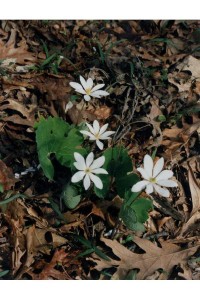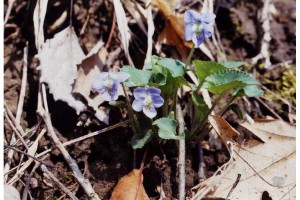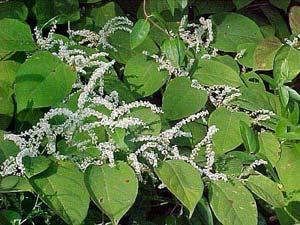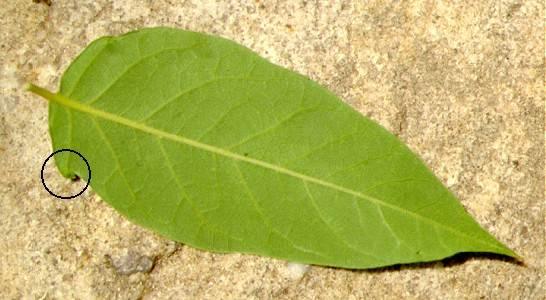The D&L Blog

Written by Jerry Rogers
With spring in full bloom, a variety of flowers are emerging with the new season. Early April is a great time to get out on the trail and enjoy the native flowers that are blooming this time of the year. Hopefully, this blog will help familiarize you with several of the plant species you might encounter on your journey. Many of these plants are tucked away along the trail, but a keen eye will be able to spot them from the trail. Please be courteous and observe the flowers with your eyes. Picking the flowers is not recommended, so please have your camera ready instead. For more information or resources on native plants, please visit http://iconservepa.org/plantsmart/index.htm
Native Wildflowers
Bloodroot (Sanguinaria canadensis) is usually found growing in moist woods and thickets. Flood plains, shorelines, and stream banks are also active habits for this species. The flowers are produced between March and May and include 8-12 delicate white petals with yellow reproductive centers. The bloodroot flower provides a treat for any deer looking for a snack in early spring. This fragile flower develops and rises from the center of its curled leaf, opening in full sun, and closing at night. The red juice from the underground stem was used by Native Americans as a dye for baskets, clothing, and war paint, as well as for insect repellant. This red dye in the root helped give the flower its more common name. Even the scientific name derives from the Latin sanguinarius, meaning “bleeding.”
Violet (Viola labradorica) is a perennial native that prefers a shady and moist environment. This native flower can be found along the entire length of the D&L trail and grows best in swamps, meadows, and alluvial woods. Violets have a delicate flower, and they provide a great food source for larval butterfly. The leaves and flowers of the violet are on the same stalk of this low plant. The flowers typically contain five light bluish-violet petals that are 3/4 of an inch wide. The leaves are nearly two inches long, round, and heart-shaped. The height of the entire plant is usually from 2-6 inches high. Despite their small size, violets provide springtime with a splash of color and are easy to spot along the trail.
Spicebush (Lindera benzoin) is a native shrub present along all sections of the D&L, including wet/wooded areas. The height of the bush can range from 6-17 feet tall, and this deciduous shrub has dense clusters of pale yellow flowers that bloom in April. The leaves are typically long, green, and smooth while the fruit of the spicebush is red, berry-like, and appears at the end of summer. The spicebush is also a vital host plant to butterflies. There are no commercial uses for the spicebush. However, the essential oils of the leaves, twigs, and fruits have been used for tea, and the dried fruits give off a pleasant aroma in fragrant sachets. Native Americans even used the dried fruits as a spice and the leaves for tea. Because of its habitat in rich woods, early land surveyors and settlers used the spicebush as an indicator species for good agricultural land.
Invasive Plants
Japanese Knotweed (Polygonum cuspidatum) is an invasive species from Eastern Asia. Japanese knotweed was probably introduced into the United States in the late 1800s. It was first planted as an ornamental and has also been used for erosion control. This plant can tolerate a wide range of adverse conditions and is most commonly found along streams and rivers, which makes it widespread along the D&L trail. Japanese knotweed is a shrubby, perennial that can grow over 10 feet in height. The leaves are normally oval with a pointed tip. In the summer this plant gets greenish-white flowers, which are soon followed by triangular, small seeds. Japanese knotweed is extremely difficult to control because it can re-grow from seeds or vegetative pieces. Mechanical and chemical methods are most commonly used to control Japanese knotweed, but all roots and runners must be removed to prevent re-sprouting.
Tree of Heaven (Ailanthus altissima) originated from central China and was introduced by a Pennsylvania gardener in 1748. Tree of Heaven is also called stinking sumac and was available commercially by 1840. A prolific seeder, Tree of Heaven spreads vigorously and establishes dense growth, which displaces native plants. It also produces chemicals that kill or prevent other plants from growing in its vicinity. Mature trees can reach 80 feet, and the large compound leaves can be 1 to 4 feet in length, with up to 25 smaller leaflets along the stems. Small greenish flowers are produced in June and the female trees produce flat fruits called samaras. All parts of the tree, especially the flowers, have an offensive odor, which some have likened to rotting peanuts. Correct identification is essential before removal of the tree. The elimination of female plants stop the spread of the seeds, but the entire plant must be removed because fragments left behind will re-grow.
Identification Tip: The native plant, staghorn sumac, is a close look-alike and often confused with the Tree of Heaven. A difference between the native sumac and Ailanthus is the leaf (below) of the Tree of Heaven has smooth edges with a glandular nodule on bottom of the underneath side; the native sumac leaf has serrated edges. In addition, the native sumac flowers form a reddish cone.

















